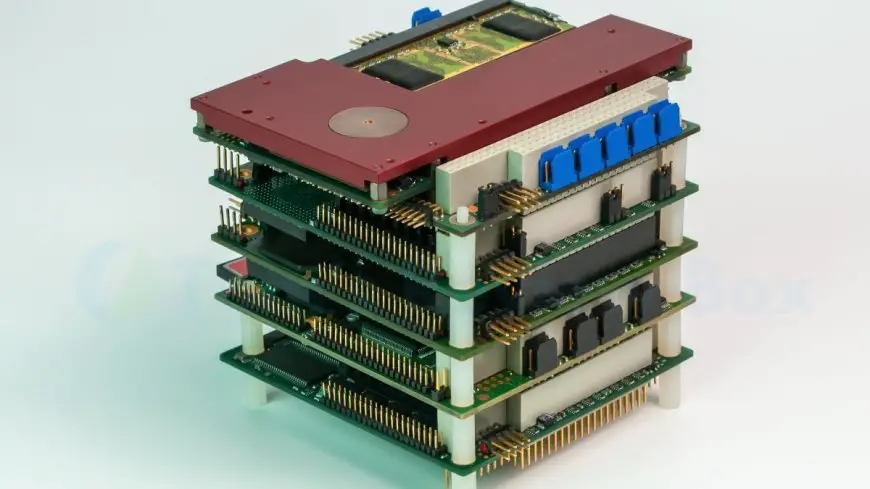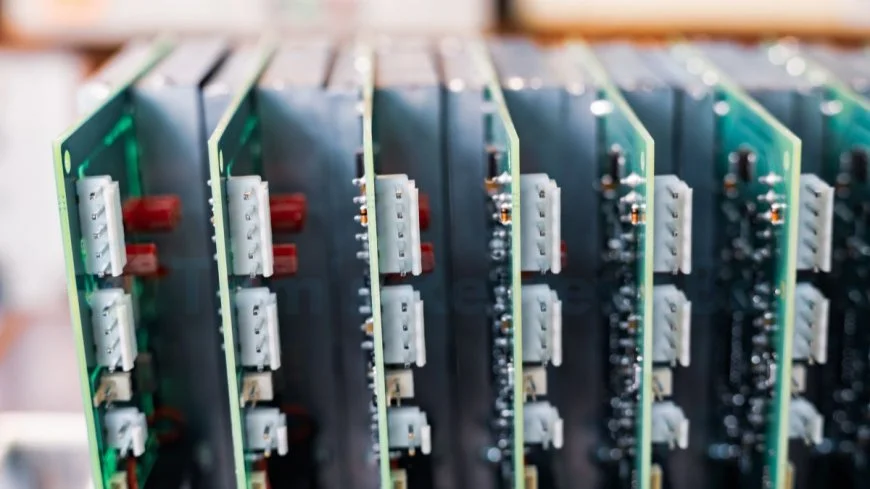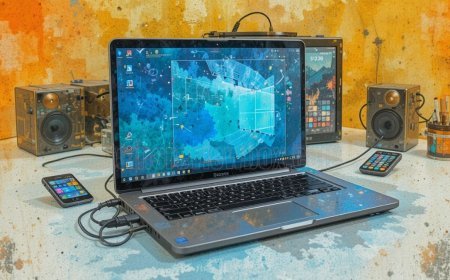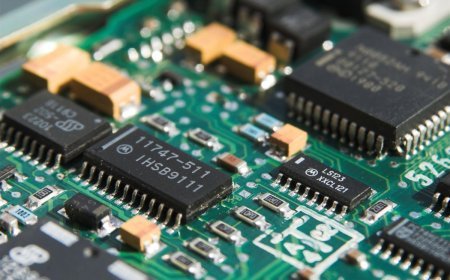Unraveling the Mystery: What Are Embedded Computers and Why Do They Matter?
Discover the secrets of embedded computers. Unveil the system's mysteries and gain a comprehensive understanding of what they are.

Did you know that over 98% of all microcontrollers and software components manufactured are used in embedded systems? These compact devices with specialized functions are everywhere, from smartphones and smartwatches to cars, vehicles, and medical equipment. Embedded computers, or microcontrollers, operate behind the scenes in electronic systems, quietly powering our daily lives without us even realizing it. But what exactly are they, and how do they work their magic, especially when it comes to computer tasks and fitting information? Let's delve into the fascinating world of embedded computers, microcontrollers to uncover their secrets and information.
Key Takeaways
-
Understand the role of embedded computers in various systems and devices.
-
Differentiate between the types of embedded systems, including standalone and real-time systems.
-
Realize the scalability of embedded systems and their applications across different industries.
-
Consider the benefits of using embedded computers, such as cost-effectiveness and efficiency.
-
Be aware of the drawbacks associated with embedded systems, like limited flexibility and upgradability.
-
When choosing an embedded PC, assess your specific needs and requirements to make an informed decision.
Defining Embedded Computers

Distinction: Embedded PCs vs. Standalone Computers
Embedded computers are specialized computing devices designed to perform specific tasks within a larger system. Unlike standalone computers, embedded systems are integrated into other equipment and do not require user interaction.
Embedded computers, such as those found in ATMs or traffic lights, focus on executing predefined functions continuously. In contrast, standalone computers like laptops or desktops cater to general-purpose computing needs.
Functions of Embedded Computers
Embedded systems excel at real-time operations, controlling machinery, collecting data, and monitoring environments. They power diverse applications like medical devices, industrial automation, consumer electronics, and automotive systems.
-
Pros:
-
Small size and low cost
-
High reliability due to fewer moving parts
-
Efficient performance tailored to specific tasks
-
-
Cons:
-
Limited flexibility compared to general-purpose computers
-
Challenges in upgrading hardware or software components
-
Embedded computers operate behind the scenes in everyday devices without direct human intervention. Their seamless integration enhances efficiency and functionality across various industries.
Types of Embedded Systems
Box PCs
Box PCs are compact computer embedded systems designed for specific applications, such as industrial automation and digital signage. They are ideal for space-constrained environments where traditional computers may not fit. Box PCs, also known as computer, typically feature robust construction to withstand harsh conditions.
Gateways
Gateways serve as intermediaries between different devices or networks, enabling communication and data transfer. These embedded systems play a crucial role in IoT ecosystems by aggregating data from various sensors and transmitting it to the cloud or other devices. Gateways ensure seamless connectivity in complex networks.
Industrial PCs
Industrial PCs, another category of embedded computer systems, are tailored for industrial settings that demand high reliability and performance. These rugged computers are built to withstand extreme temperatures, dust, and vibrations common in manufacturing environments. Industrial computers power critical operations in sectors like manufacturing, transportation, and energy.
-
Box PCs:
-
Compact design
-
Ideal for industrial automation
-
-
Gateways:
-
Enable communication between devices
-
Essential for IoT networks
-
-
Industrial PCs:
-
Built for rugged environments
-
Power operations in various industries
-
Embedded computers are indispensable components in IoT networks, facilitating seamless data exchange between connected devices. By leveraging these specialized systems, organizations can enhance operational efficiency and enable real-time monitoring and control across diverse applications.
The applications of embedded computers span across multiple industries, including healthcare, automotive, aerospace, and consumer electronics. In healthcare, embedded systems, powered by computer technology, drive medical devices like patient monitors and imaging equipment, enhancing diagnostics and patient care. The automotive sector relies on these computer systems for functions like engine control units and infotainment systems.
Embedded Systems in Real-Time
Instant Data Processing
Embedded systems, like microcontrollers, excel in real-time performance by swiftly processing data for critical applications. These electronic computer systems are designed to handle specific tasks instantaneously, ensuring timely responses. With their ability to execute commands rapidly, embedded systems, like computers, play a crucial role in various industries.
Real-time embedded systems are utilized in scenarios where time performance is of utmost importance. For instance, in the automotive sector, these computer systems manage various components within a vehicle to meet the stringent performance requirements. They ensure that computer data is processed promptly, enabling features like engine control and safety mechanisms to function seamlessly.
Essential Applications
In robotics and automation, real-time embedded computer systems are indispensable. These computer systems facilitate the swift execution of tasks by processing information with minimal delay. In industrial automation, for example, embedded systems, like computers, control machinery movements with precision and accuracy. By responding to inputs instantly, they enhance operational efficiency, productivity, and computer.
In the healthcare sector, real-time embedded systems are employed in medical devices such as heart monitors and infusion pumps. These devices rely on instantaneous data processing to monitor vital signs and deliver medication accurately. The seamless operation of these devices is critical for patient care and safety.
Standalone Embedded Systems
Software Components
Standalone embedded systems are self-sufficient software components designed to perform a single task or a specific task. They operate independently like a computer without the need for continuous external connections.
These computer systems are tailored to execute a dedicated function, such as monitoring temperature in a refrigerator or controlling the air conditioning in a car. Due to their focused nature, they excel in scenarios where reliability and efficiency are paramount.
Advantages in Specific Applications
-
Reliability: Standalone embedded systems are known for their robustness and stability since they are not affected by external factors.
-
Efficiency: By concentrating on a single task, these systems optimize resource usage and deliver high performance.
-
Cost-Effectiveness: Their streamlined design reduces unnecessary features, making them cost-effective for mass production.
-
Security: With limited access points, standalone embedded systems offer enhanced security against cyber threats.
In specific applications like medical devices, industrial automation, and consumer electronics, standalone embedded computer systems play a crucial role. For instance, in medical equipment like pacemakers, these systems ensure accurate and timely delivery of life-saving functions without interruptions.
By focusing solely on the designated task, standalone embedded systems enhance operational efficiency and minimize the risk of errors. In industrial settings, these systems control machinery with precision and reliability, contributing to increased productivity and safety measures.
In consumer electronics such as smart home devices or wearable gadgets, standalone embedded systems enable seamless user experiences by handling tasks efficiently. For example, in smart thermostats that regulate home temperature based on user preferences, these systems ensure smooth operation without delays.
The simplicity and effectiveness of standalone embedded systems make them indispensable in various sectors where performance and reliability are non-negotiable requirements.
Embedded Systems Scale
Flexibility in Adaptation
Embedded systems are highly versatile, fitting into various project sizes seamlessly. They can be customized to meet specific features and functionalities required for different applications. The storage capacities of these systems can be adjusted based on the project's needs.
Embedded computers come in diverse form factors, allowing them to be integrated into IoT devices of all sizes. This adaptability makes them ideal for a wide range of projects, from small-scale consumer electronics to large industrial machinery.
Scalability Benefits
-
Embedded systems offer scalability benefits in IoT and industrial settings:
-
They can easily accommodate the increasing demands of IoT networks by expanding their processing power and memory.
-
In industrial environments, embedded systems can scale up to control complex automation processes efficiently.
-
Benefits of Embedded Computers
Small Form Factor
Embedded computers offer the advantage of a small form factor, making them ideal for applications with limited space. They can be seamlessly integrated into various devices without taking up much room. This compact size is crucial in scenarios where size constraints are paramount, such as in medical devices or automotive systems.
Low Maintenance Requirement
Embedded computers, like guidance computers, are designed for continuous operation with minimal intervention. Their robust construction and efficient design ensure that they require low maintenance, reducing downtime and operational costs. This reliability makes them suitable for critical tasks where uninterrupted performance is essential.
Efficient Cooling Mechanisms
Embedded computers incorporate efficient cooling mechanisms to maintain optimal operating temperatures. These mechanisms prevent overheating and ensure stable performance even in demanding environments. By efficiently dissipating heat, these systems enhance reliability and longevity, crucial factors in applications where consistent performance is vital.
Drawbacks of Using Embedded Systems
Cost Considerations
Embedded systems come with certain drawbacks that need to be considered, particularly in terms of cost considerations. One significant drawback is the initial investment required for developing and implementing embedded systems. The costs associated with designing custom hardware and software solutions can be substantial, especially for complex projects.
Moreover, ongoing maintenance and support expenses can add up over time. Cost considerations also extend to scalability issues. As technology evolves rapidly, embedded systems may become outdated quickly, requiring frequent updates or replacements to keep up with advancements. This continuous cycle of upgrades can result in significant long-term costs for businesses.
Customization Challenges
One major challenge related to embedded systems is the customization process. While off-the-shelf solutions offer convenience, they may not always meet the specific requirements of a particular application. Customizing embedded systems to suit unique needs can be time-consuming and costly. It often involves extensive testing and debugging to ensure compatibility with existing infrastructure.
Integrating customized embedded systems into an organization's workflow can present compatibility issues with legacy systems or other technologies. Ensuring seamless integration without disrupting operations requires careful planning and expertise. Failure to address these challenges effectively can lead to operational inefficiencies and downtime.
Mitigating Drawbacks through Strategic Considerations
To mitigate the drawbacks associated with using embedded systems, several strategic considerations can be implemented. Firstly, conducting a thorough cost-benefit analysis before embarking on an embedded system project is crucial. This analysis helps in evaluating the potential return on investment and identifying areas where cost-saving measures can be implemented.
Furthermore, prioritizing scalability during the design phase allows for future expansion and upgrades without incurring excessive costs. Choosing modular components that can be easily replaced or upgraded helps in adapting to changing technological landscapes efficiently.
Lastly, collaborating with experienced embedded system developers who have a proven track record in delivering successful projects can mitigate customization challenges. Their expertise ensures that customized solutions are developed efficiently, meeting specific requirements while minimizing risks associated with compatibility issues.
Industry Applications of Embedded Computers
Automotive Sector
Embedded computers play a crucial role in the automotive industry, powering various systems within vehicles. They are used for computing systems that control engine functions, safety features, and entertainment systems. In modern cars, embedded computers ensure efficient performance and enhanced driving experience.
In the automotive sector, embedded computers enable advanced driver assistance systems (ADAS) that enhance safety on the roads. These systems utilize microcontrollers to process data from sensors and make real-time decisions to prevent accidents. Embedded computers are integral to autonomous vehicles, enabling them to navigate roads autonomously.
Healthcare Industry
In healthcare, embedded computers are utilized in medical devices such as pacemakers, insulin pumps, and MRI machines. These devices rely on computing systems to monitor vital signs, deliver precise doses of medication, and generate detailed imaging results. Embedded computers ensure accuracy and reliability in critical healthcare equipment.
One innovative example is the use of embedded computers in wearable health monitors. These devices track vital signs like heart rate and blood pressure continuously, providing valuable data for users and healthcare professionals. The seamless integration of embedded computers in healthcare devices has revolutionized patient care and monitoring.
Retail Applications
The retail sector leverages embedded computers for various purposes, including inventory management, point-of-sale systems, and customer analytics. These computing systems streamline operations by tracking stock levels accurately, processing transactions efficiently, and analyzing consumer behavior patterns. Embedded computers enhance overall efficiency in retail settings.
An interesting application is the use of embedded computers in smart shelves that automatically update inventory levels in real-time. This technology eliminates manual stock checks and ensures shelves are always well-stocked with popular products. By integrating embedded computers, retailers can optimize their supply chain management processes effectively.
Choosing the Right Embedded PC
Application Specific
When selecting an embedded PC, consider the specific requirements of the application. Different projects demand varying levels of processing power, memory, and connectivity. Ensuring that the embedded PC aligns with these needs is crucial for optimal performance.
Expert Consultation
Seeking advice from specialists in embedded systems can provide valuable insights into choosing the right device. These experts can analyze project specifications and recommend the most suitable embedded computer based on factors like size constraints, power efficiency, and environmental durability.
Tailored Recommendations
Consulting with professionals can result in tailored recommendations that cater to the unique demands of a project. Whether it's for industrial automation, IoT applications, or robotics, expert guidance ensures that the chosen embedded PC meets all necessary criteria for seamless integration and operation.
Summary
Embedded computers are versatile systems found in various industries, offering real-time processing and scalability. While they bring numerous benefits like efficiency and cost-effectiveness, drawbacks such as limited flexibility exist. Understanding the types and applications of embedded systems can help you make informed decisions when choosing the right one for your needs. By recognizing the significance of embedded computers in modern technology, you can leverage their capabilities to enhance your projects and operations.
Incorporating embedded systems strategically can revolutionize how you approach technological challenges, optimize processes, and streamline workflows in your industry. Take the time to explore the diverse applications and benefits these systems offer, ensuring you harness their full potential for innovation and growth in your endeavors.
Frequently Asked Questions
What are embedded computers?
Embedded computers are specialized computing systems designed to perform specific tasks within larger systems. They are typically dedicated to a single function, such as controlling machinery or monitoring sensors, and are integrated into devices we use daily.
How do embedded systems differ from regular computers?
Embedded systems are tailored for specific applications and often have limited resources compared to regular computers. They are built into the devices they control and operate in real-time with minimal human intervention.
What industries benefit from using embedded computers?
Various industries leverage embedded computers, including automotive (for vehicle control systems), healthcare (medical devices), consumer electronics (smartphones, IoT devices), aerospace (flight control systems), and industrial automation (robotics).
What advantages do embedded computers offer?
-
Compact size and lower cost
-
Enhanced reliability due to fewer moving parts
-
Efficient power consumption for long-term operation
-
Customizable for specific functions leading to optimized performance
Are there any drawbacks to using embedded systems?
-
Limited processing power may restrict complex operations
-
Upgrades or modifications can be challenging
-
Security vulnerabilities due to connectivity risks
-
Potential compatibility issues with new technologies
How should one choose the right embedded PC?
When selecting an embedded PC, consider factors like processing power, memory requirements, I/O interfaces needed, operating temperature range, form factor compatibility, long-term availability of components, and vendor support for future upgrades or maintenance.
What's Your Reaction?







































![MacBook Pro M5: All the features and specs you need to know [LEAKS REVEALED]](https://tomsreviewbox.com/uploads/images/202502/image_430x256_67bd6d7cd7562.jpg)



























